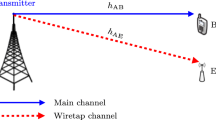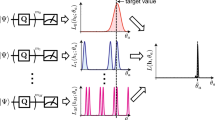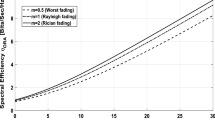Abstract
Quadrature spatial modulation (QSM), where the real and imaginary parts of the transmitted symbol are transmitted separately, was recently proposed to increase the spectral efficiency of spatial modulation. An optimum maximum likelihood (ML) detection was introduced in QSM systems, which leads to high complexity as the exhausting search of all possible transmit antennas. In this paper, a low complexity detection, called signal vector based minimum mean square error (SVMMSE), is proposed for QSM systems. In the proposed SVMMSE detection, we estimate the transmit antenna indices and the transmitted symbol by considering the active transmit antennas in two different scenarios. Simulation results show that the performance of our SVMMSE detection is very close to the ML detection and complexity analysis shows that the computational complexity of the proposed SVMMSE detection is significantly reduced compared with that of the ML detection.




Similar content being viewed by others
References
Mesleh, R., Haas, H., Ahn, C. W., & Yun, S. (2006). Spatial modulation—a new low complexity spectral efficiency enhancing technique. In Proceedings of Communications and Networking in China (pp. 1–5).
Mesleh, R., Haas, H., Sinanovic, S., Ahn, C. W., & Yun, S. (2008). Spatial modulation. IEEE Transactions on Vehicular Technology, 57(4), 2228–2241.
Jeganathan, J., Ghrayeb, A., Szczecinski, L., & Ceron, A. (2009). Space shift keying modulation for MIMO channels. IEEE Transactions on Wireless Communications, 8(7), 3692–3703.
Younis, A., Serafimovski, N., Mesleh, R., & Haas, H. (2010). Generalised spatial modulation. In Signals, systems and computers (pp. 1498–1502).
Jeganathan, J., Ghrayeb, A., & Szczecinski, L. (2008) Generalized space shift keying modulation for MIMO channels. In Proceedings of IEEE 19th International Symposium on Personal, Indoor and Mobile Radio Communications (pp. 1–5).
Jeganathan, J., Ghrayeb, A., & Szczecinski, L. (2008). Spatial modulation: optimal detection and performance analysis. IEEE Communications Letters, 12(8), 545–547.
Wang, J., Jia, S., & Song, J. (2012). Signal vector based detection scheme for spatial modulation. IEEE Communications Letters, 16(1), 19–21.
Jianping, Z. (2012). Signal vector based list detection for spatial modulation. IEEE Wireless Communications Letters, 1(4), 265–267.
Zhang, W., & Yin, Q. (2014). Adaptive signal vector based detection for spatial modulation. IEEE Communications Letters, 18(11), 2059–2062.
Tang, Q., Xiao, Y., Yang, P., Yu, Q., & Li, S. (2013). A new low-complexity near-ML detection algorithm for spatial modulation. IEEE Wireless Communications Letters, 2(1), 90–93.
Jianhong, Z., Xiaobo, Y., & Zhe, L. (2014). Low-complexity detection method for spatial modulation based on M-algorithm. Electronics Letters, 50(21), 1552–1554.
Rajashekar, R., Hari, K. V. S., & Hanzo, L. (2014). Reduced-complexity ML detection and capacity-optimized training for spatial modulation systems. IEEE Transactions on Communications, 62(1), 112–125.
Hongzhi, M., & Minglu, J. (2014). A low-complexity ML detection algorithm for spatial modulation systems with MPSK constellation. IEEE Communications Letters, 18(8), 1375–1378.
Jintao, W., Shuyun, J., & Jian, S. (2012). Generalised spatial modulation system with multiple active transmit antennas and low complexity detection scheme. IEEE Transactions on Wireless Communications, 11(4), 1605–1615.
Sugiura, S., Chao, X., Soon Xin, N., & Hanzo, L. (2012). Reduced-complexity iterative-detection-aided generalized space-time shift keying. IEEE Transactions on Vehicular Technology, 61(8), 3656–3664.
Younis, A., Di Renzo, M., Mesleh, R., & Haas, H. (2011). Sphere decoding for spatial modulation. In Proceedings of 2011 IEEE international conference on communications (ICC) (pp. 1–6).
Younis, A., Sinanovic, S., Di Renzo, M., Mesleh, R., & Haas, H. (2013). Generalised sphere decoding for spatial modulation. IEEE Transactions on Communications, 61(7), 2805–2815.
Mesleh, R., Ikki, S., & Aggoune, H. M. (2015). Quadrature spatial modulation. IEEE Transactions on Vehicular Technology, 64(6), 2738–2742.
Xiao, Y., Yang, Z., Dan, L., Yang, P., Yin, L., & Xiang, W. (2014). Low-complexity signal detection for generalized spatial modulation. IEEE Communications Letters, 18(3), 403–406.
Younis, A., Thompson, W., Di Renzo, M., Wang, C.-X., Beach, M. A., Haas, H. & Grant, P. M. (2013). Performance of spatial modulation using measured real-world channels. In Proceedings of 78rd IEEE vehicular technology conference (VTC Fall) (pp. 1–5).
Serafimovski, N., Younis, A., Mesleh, R., Chambers, P., Di Renzo, M., Wang, C.-X., et al. (2013). Practical implementation of spatial modulation. IEEE Transactions on Vehicular Technology, 62(9), 4511–4523.
Wu, X., & Thompson, J. S. (2009). Accelerated sphere decoding for multipleinput multiple-output systems using an adaptive statistical threshold. IET Signal Processing, 3(6), 433–444.
Handte, T., Müller, A., & Speidel, J. (2009). BER analysis and optimization of generalized spatial modulation in correlated fading channels. In Proceedings of IEEE vehicular technology conference fall (pp. 1–5).
Fan, R., Yu, Y., & Guan, Y. (2015). Generalization of orthogonal frequency division multiplexing with index modulation. IEEE Transactions on Wireless Communications, 14(10), 5350–5359.
Zheng, B., Chen, F., Wen, M., Ji, F., Yu, H., & Liu, Y. (2015). Low-complexity ML detector and performance analysis for OFDM with inphase/quadrature index modulation. IEEE Communications Letters, 19(11), 1893–1896.
Acknowledgements
This work was supported by MEST 2015R1A2A1A05000977, NRF, South Korea, Shanghai Rising-Star Program (15QA1400100), National Natural Science Foundation of China (61671143) and the Brain Korea 21 PLUS Project, National Research Foundation of Korea.
Author information
Authors and Affiliations
Corresponding author
Rights and permissions
About this article
Cite this article
Li, J., Jiang, X., Yan, Y. et al. Low Complexity Detection for Quadrature Spatial Modulation Systems. Wireless Pers Commun 95, 4171–4183 (2017). https://doi.org/10.1007/s11277-017-4057-y
Published:
Issue Date:
DOI: https://doi.org/10.1007/s11277-017-4057-y




